Tuesday, June 13, 2006
I couldn't resist....
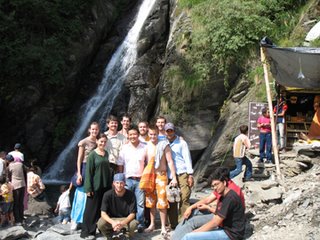

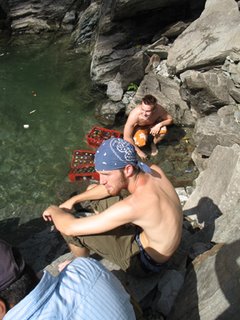
Here are a few good pix, taken by a few of us, during our travels through India.
There are a couple more articles in store for the Daily Reflector (June 17 and 25).
I may have a few more posts left in me just yet, so keep stopping by!
There are some shots of
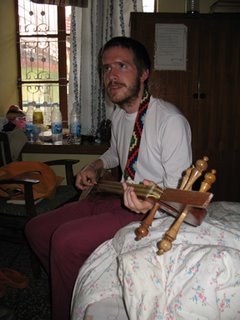 the waterfall in Dharamsala; a
the waterfall in Dharamsala; a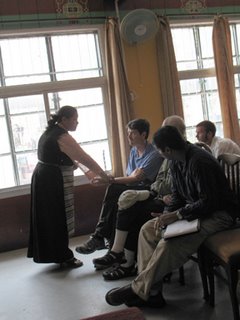 photo of Nathan with another stringed instrument; photos of a fine doctor from the Tibetan medicine school offering us a lecture on her profession; Dani holding a baby; a soda with so much carbonation that it yielded a rather large bubble.
photo of Nathan with another stringed instrument; photos of a fine doctor from the Tibetan medicine school offering us a lecture on her profession; Dani holding a baby; a soda with so much carbonation that it yielded a rather large bubble.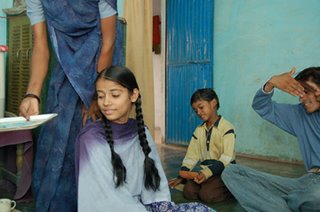


Friday, June 09, 2006
Cooler Daze in India
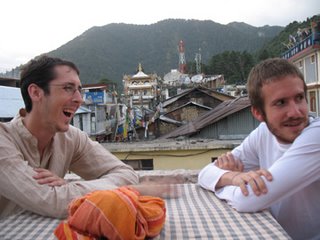
We have made it to McLeod Ganj, a Tibetan village just north of Dharamsala. The weather is cooler, the streets are safer and the flavor and tone of the region is very laid back and relaxing. There are more westerners here than in the other places we’ve visited.
In the past few days, we’ve taken quite a few trail walks in these hills, most notably to the Tibetan Children’s Village and to this massive waterfall. The source of the waterfall is the snow runoff from the Himalayan mountains a few hundred miles away. After climbing to the waterfall site, a few of us took the plunge and, for the first time in a month, got to swim.
Independent projects are underway these days. Ashley and Dani have met with a woman who conducts research on Tibetan nuns; JT has met a film director at the Tibetan Institute of Performing Arts; Nabeel has approached a doctor of Tibetan medicine and has a few capsules that he hopes to bring back home to analyze under a microscope and spectrometer; Bob has met with a Tibetan metal smith and continues with Aleta to craft collages of scraps and bits of Indian street life; James and Geoff will soon spend a few days in solitude on a meditation retreat.
of Tibetan medicine and has a few capsules that he hopes to bring back home to analyze under a microscope and spectrometer; Bob has met with a Tibetan metal smith and continues with Aleta to craft collages of scraps and bits of Indian street life; James and Geoff will soon spend a few days in solitude on a meditation retreat.
It is interesting to be in McCleod Ganj. This is the home of the Dalai Lama, and many, many Tibetans who have fled China (which claims to view Tibet as part of China). The precariousness of the terrain seems to inform, or illustrate in some way, the careful balance required of surviving on the edge of a precipice. There is an unsettled feeling here in spite of the c ozy, homey spaces the Tibetans have managed to carve out for themselves. They are refugees, but have managed to create institutions and organizations that will ensure that their culture and traditions will continue.
ozy, homey spaces the Tibetans have managed to carve out for themselves. They are refugees, but have managed to create institutions and organizations that will ensure that their culture and traditions will continue.
This is the final blog… as far as I can tell. I leave tomorrow morning for Delhi, and then I’m off back home to the United States. I may post a line or two of reflection when I get a chance.
The rest of the group will remain in Dharamsala for a few more days before they, too, leave India for the places they call home.
Thank you for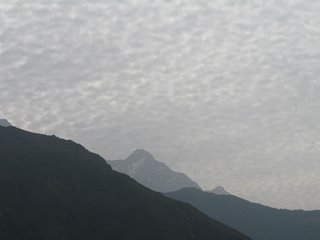 reading and for your message
reading and for your message s of support of our endeavors here in India.
s of support of our endeavors here in India.
Tuesday, June 06, 2006
Commerce and Communion in India...
http://www.reflector.com/featr/content/features/stories/2006/06/04/india.html
Monday, June 05, 2006

Amid the hundreds of robed monks and Buddhist tourists who come to the small Indian village of Bodh Gaya, there is a roadside shop that sells masks and chains. Key chains, that is. The masks are hyper bright and eerie-scary. It’s harder to say which is most scary: There’s Tweety Bird and Batman and a Donald Duck masks that are slightly off in their look and coloring, as though a warning signal has gone off because the masks before you do not jibe with the icon ingrained your mind. There are also silvery cat masks; a clown too pink to be pleasant, like everything you ever feared in a circus has culminated in this one mask. There are devil-masks, complete with horns, a few skeletons, and a lone mask of Hanuman (the Hindu monkey god). We felt oddly ill at ease looking at them, but like so many car wrecks, we had to stop.
And of course, for 20 rupees apiece, Nathan and I could not resist buying a few to share with our loved ones back home. A few days later, on the train from Gaya to Delhi, he tried to spook out our train attendant by taking his morning tea with the cat mask. The gesture elicited no response.
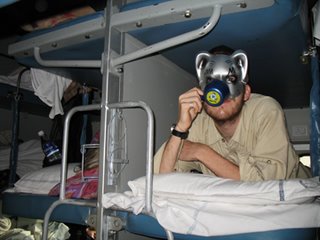
Bodh Gaya has been a great place for resting for us. In our own time, and as part of a group, each of us has made it to the Mahabodhi Temple, the site of the Buddha’s enlightenment. Of course, when he was actually here, there was no stories high monumnent, no crystal-embedded throne, no little stupas and pillars of worship dotting the areas. At the beginning, there was one simple tree and one man. The current bodhi tree at the site is a descendent of the original bodhi tree, according to the guidebooks.
One evening, James, Derek and I went to visit the temple after dark. It was a nice evening, and the moths and all light-loving insects (so, all of them) were out in full-force basking in the spotlights that illuminated the temple and the tree. We walked along the temple’s outer path, and then sat outside in front of the great bodhi tree. The tree is protected, behind ba
 rs, so to speak, to protect it. Two of its many large limbs are held up with metal supports and people offer it water daily. On occasion, the tree will drop a few leaves. From dawn to dark, people come to sit around the tree, or inside the temple, or on any one of the little platforms and cement shines that surround it. On this particular evening, as we sat under the tree, avoiding the insects that would haphazardly bombard us (but not bite or sting) from time to time, the three of us were able to watch a monk become ordained. It was a small ceremony, just a few family members were present and three monks in dark red robes. The man, whose head was already shaved close, was dressed at first in street clothes, a Tshirt and pants. At one point, he kneeled and offered the monks a beautifully folded cylinder of cloth. It occurred to me that these were his robes, and would soon become his sole possession. Monks of other orders (you can tell by the color and style of their robes), stood or sat around the small group. A few of them took photos and smiled with these giddy grins. There was one who clasped his hands, rejoicing at the site. At the end, his mother offered him his alms bowl, and many of us around the temple, gave small offerings of money, incense and food. The guard came by and said it was time to close the temple.
rs, so to speak, to protect it. Two of its many large limbs are held up with metal supports and people offer it water daily. On occasion, the tree will drop a few leaves. From dawn to dark, people come to sit around the tree, or inside the temple, or on any one of the little platforms and cement shines that surround it. On this particular evening, as we sat under the tree, avoiding the insects that would haphazardly bombard us (but not bite or sting) from time to time, the three of us were able to watch a monk become ordained. It was a small ceremony, just a few family members were present and three monks in dark red robes. The man, whose head was already shaved close, was dressed at first in street clothes, a Tshirt and pants. At one point, he kneeled and offered the monks a beautifully folded cylinder of cloth. It occurred to me that these were his robes, and would soon become his sole possession. Monks of other orders (you can tell by the color and style of their robes), stood or sat around the small group. A few of them took photos and smiled with these giddy grins. There was one who clasped his hands, rejoicing at the site. At the end, his mother offered him his alms bowl, and many of us around the temple, gave small offerings of money, incense and food. The guard came by and said it was time to close the temple.We left the temple and walked back to our hotel and heard loud music. We didn’t think too much of it, but when we arrived in the lobby, we found that JT and Jamie and Bret, Josh, Dani, Nabeel, Geoff, and Nathan
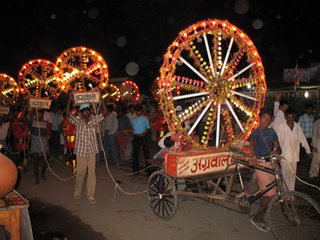 were about to go where the music was. It turned out it was the beginning of a wedding, called the Bharat. The Bharat is a procession the groom’s family makes to the bride’s village. This particular bharat had the feel of a dance party parade. Leading the procession was a rattling generator, which fueled the cascade of lights and music that flooded the streets. Men balanced wheels of light and tinsel on their heads; there were others in red uniforms and band caps with trumpets and horns and drums at the ready in their hands. A Public Address system attached to a silvery cart was responsible for the musical broadcast. The parade had just started, and there was lots of dancing. Many of the boys in our group got pulled into the fray and danced in celebration of a couple they were never going to meet. They eventually filtered out of the craziness, one by one, and the parade went on its way, through the hard-packed dirt streets of Bodh Gaya, to a bride and her family.
were about to go where the music was. It turned out it was the beginning of a wedding, called the Bharat. The Bharat is a procession the groom’s family makes to the bride’s village. This particular bharat had the feel of a dance party parade. Leading the procession was a rattling generator, which fueled the cascade of lights and music that flooded the streets. Men balanced wheels of light and tinsel on their heads; there were others in red uniforms and band caps with trumpets and horns and drums at the ready in their hands. A Public Address system attached to a silvery cart was responsible for the musical broadcast. The parade had just started, and there was lots of dancing. Many of the boys in our group got pulled into the fray and danced in celebration of a couple they were never going to meet. They eventually filtered out of the craziness, one by one, and the parade went on its way, through the hard-packed dirt streets of Bodh Gaya, to a bride and her family.Thursday, June 01, 2006
Living in Transition and Stasis: Bodh Gaya

In the past few days, we have transitioned
 geographically from Khajuraho to Varanasi. Now we have arrived in Bodh Gaya. We have traveled across the parched land by Jeep and train and motor rickshaw, passing
geographically from Khajuraho to Varanasi. Now we have arrived in Bodh Gaya. We have traveled across the parched land by Jeep and train and motor rickshaw, passing  the time by playing games, offering each other “top three” best songs of all time or catching a few zzz’s when we can. In Varanasi, we waited on a train platform for hours, melting from the heat and drinking overpriced bottled water and soda and Lays brand potato chips. Now that we are in Bodh Gaya, a feeling of calm has crept over the group. We know we’ll be staying here for a few days and we are glad to make whatever stasis we can find feel like home. This afternoon, Many of the students went off to see a matinee in Gaya. I have asked them to deliver a full report for the blog when they return.
the time by playing games, offering each other “top three” best songs of all time or catching a few zzz’s when we can. In Varanasi, we waited on a train platform for hours, melting from the heat and drinking overpriced bottled water and soda and Lays brand potato chips. Now that we are in Bodh Gaya, a feeling of calm has crept over the group. We know we’ll be staying here for a few days and we are glad to make whatever stasis we can find feel like home. This afternoon, Many of the students went off to see a matinee in Gaya. I have asked them to deliver a full report for the blog when they return.Today is “Indian Dress” day. Nathan and James reported they received a few snickers from the hotel staff when they came downstairs this morning for breakfast. “It’s probably the equivalent of an Indian coming to America and wearing a full-garb cowboy suit,” Nathan joked. Many of them have fully embraced Indian music and clothes. Lynda, Dani and Ashley have bought saris or salwar kamiz. In addition to their kurtas (long shirts), a few of the guys, inspired by the two evenings of Indian Classical music in Varanasi, have bought sitars, tablas and a lone wooden flute. Nathan bought a pair of spiffy orange flip flops that gave him blisters. He’ll
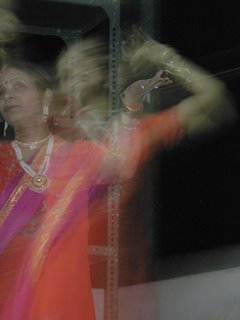 break them in yet.
break them in yet.It’s amazing to me how each place we visit has its own personality. Khajuraho, in spite of its beautiful temples, had the somewhat seedy feel of a beach town during the off-season. The tourist distric
 t around the temples relies heavily on people like us, and so to have 16 people drop in during the Hot Season was a boon for business. Varanasi, aside from the handful of touts and rickshaw drivers outside our hotel, felt too large and ancient to take any real notice that we were there. We were mere blips on its radar screen, just another group of people coming to see the famed Ganges River and to walk through its maze of colorful, narrow streets. In Bodh Gaya, the site of the Buddha’s enlightenment and home to the Mahabodhi Temple, there is a calmness unlike any other place we have visited. There are monks of many disciplines, with shaved heads and a range of colored robes, from saffron yellow of the Southeast Asian monks to the deep red hues of the Tibetans. There is space here for contemplation, and each of u
t around the temples relies heavily on people like us, and so to have 16 people drop in during the Hot Season was a boon for business. Varanasi, aside from the handful of touts and rickshaw drivers outside our hotel, felt too large and ancient to take any real notice that we were there. We were mere blips on its radar screen, just another group of people coming to see the famed Ganges River and to walk through its maze of colorful, narrow streets. In Bodh Gaya, the site of the Buddha’s enlightenment and home to the Mahabodhi Temple, there is a calmness unlike any other place we have visited. There are monks of many disciplines, with shaved heads and a range of colored robes, from saffron yellow of the Southeast Asian monks to the deep red hues of the Tibetans. There is space here for contemplation, and each of u s in our own way welcome it fully.
s in our own way welcome it fully.I had the opportunity to visit Bodh Gaya in 1995 and it was interesting for me to see how much it had changed. There are certainly more shops around the Mahabodhi temple, and Internet stores are on every corner. But the Burmese Vihar (where I had stayed) is still operating. The streets are still dusty and made of hard-packed dirt. There are a great many new monasteries that have been built, including the stunning hundreds of feet high Buddha at the Japanese Temple. Yesterday, we visited sites very important to Buddhists. One is Vulture Peak in Rajagir, a place where the Buddha and his followers would stay during the rainy season. There we saw two caves, one where Ananda lived (the Buddha’s cousin) and the other where Sariputra lived (a chief disciple of the Buddha). The peak area is where a rather famous sutra, known as the Heart Sutra, was first expounded. It offers an outline of the key concepts of “nothingness” in Buddhist philosophy.
When we arrived, there were little shops and trinkets and wastebaskets in the form of penguins and rabbits. This was not as I remembered Vulture Peak. There was a brick-paved walkway, and a few meters away, a colorful ski-lift that would bring you to the top of the mountain (but not to Vulture Peak). To my surprise, the entire path to both caves and the peak was paved. Touts with mallas and books and postcards followed us on our walk. A pack of dogs did as well. These were the most relaxed dogs I have ever seen. I think they dug our “pack” and liked being part of it. They didn’t beg or call attention to themselves in any way. They simply liked the company; they liked going for a walk like any other dog might. When we reached Vulture Peak, instead of the natural plateau that overlooked the valley, there was a brick-constructed shrine area, and a brick wall that served as a sort of observation deck. There a man in a dhoti offered each of us a stick of incense and a silk lotus flower to place on the shrine. The shrine was too intricate, shiny gold and white silk and platters of offerings and flowers and money. In the center, right before the Buddha, was a good old American Ben Franklin. It kind of set the tone for me, even though I placed the incense and flower and a money offering somewhere on the shrine. Where was the open, natural space? Why were people demanding offerings and trying to sell us things? Why had the road to this sacred place become so accessible?
After a half hour, we walked down the path and there we found our little pack of dogs waiting for us. We descended to the foot of the mountain, past the postcard salesmen and Limca soda vendors, past the beggars and penguin wastebaskets and men selling Kit Kats and into the refuge of our air conditioned bus. It was hard not to feel disappointed by the change in the feel of Vulture Peak. But many religious sites in India now have a tourism edge to it. On the one hand, making these sites family friendly is a feasible way to build tourism and the economy. Many Indians who go on vacation oftentimes visit religious sites in their own country. There is no Disneyland equivalent here. On the other hand, the question of how attempts to modernize and upgrade changes the tone and feel of these spaces cannot be ignored. Just by being here, we are in a way contributing to it.
But I have to wonder: What would have happened if the path to Vulture Peak was always this easy?
Wednesday, May 31, 2006
No lions or tigers on Jungle visit...
Thursday, May 25, we had some time before our midnight departure from Khajuraho, so we decided to venture to the outskirts of the city and view the waterfall. We were informed earlier that the water had dried up in the hot season so there was just a “fall” (no water) but having viewed most of the temples in the area already we were up for a change of scenery.
The beautiful rock structures of the fall gave a real impression of the incredible amount of time that had passed to create it. Surely the gorge must rival the majesty of our own Grand Canyon. It was hard to believe that where we were standing would soon be covered with water during the Monsoon season. We saw photographs of the very spot. The silence of this place was spectacular. We all enjoyed it amid the occasional lively philosophical conversations between evolution versus creationism.
Our tour guides took us further into the park, down a nature train by Jeep and we saw several kinds of animals. There were many antelope, described as “big deer” by Josh. And on the way out, we stopped to observe a group of black-faced monkeys that had congregated in the woods. They looked like animals until you see them interacting and then you can’t help but notice how human they seem. We never did see any tigers or crocodiles. They were too smart to come out in this heat.
Upon our return to the hotel we stopped at an extremely small village and handed out a few pencils to the residents. I don’t think they had visitors often, so we were quite the center of attention when we arrived. I think we were all surprised at how different things were, only a few kilometers outside of Khajuraho. It was a great cultural experience.
James Tyndall
Tuesday, May 30, 2006
A reflection on Transplant Shock
I am an orchid. My husband is a dandelion.
My name is Aleta Braun. His name is Robert Ebendorf. If you are a regular with this blogspot, then you met him last week. We are both artists.
Several summers ago, we spent most of the season on the road, visiting friends, living out of the car. While I took a painting class at Art New England in Bennington, VT, Bob taught a class in Shrines, Altars and Icons. Before leaving Greenville, we each packed a box or two that we labeled “Aleta studio” and “Bob studio”. The plan was that when we arrived at each point along the way, we would unpack what we needed and set up our little portable studios. The engine on the car hadn’t even cooled and Bob was unpacked, installed and I could hear the ping ping of his little hammer on metal or the snip snip of scissors on paper for collage material.
Meanwhile, my “Aleta studio” box sat on the table as I was scoping out the situation, going for a walk through my new neighborhood – generally assessing the lay of the land, “getting the feel of the place in my senses”. This is a time when I need to sink my roots into the new soil before expecting to see a blossom. Bob, as a dandelion, was doing something similar but it’s easier to have the right conditions for growth.
It takes a while to begin to see a pattern emerge. A few years passed before I named our behavior in terms of flowers. Over time, I watched as Bob would quickly acclimate like a weed to any environment. I, on the other hand, require the right conditions to survive and thrive. If the conditions are too harsh, it invokes “Transplant Shock”.
During the month before our departure for India, Bob and I were soaking and planting last year’s seeds from the Moonflower plants the Butterfly Moths so enjoyed in our backyard at dusk. It was an enjoyable springtime project that allowed us to watch the growth of the seedlings by the minute. After they were large and sturdy enough, Bob planted several in the ground. The next day he was concerned, “the ones I planted yesterday look sort of droopy compared to the ones that are still in pots on the deck.” “They’re suffering transplant shock,” I answered and explained that the quick change in environment gives the plants a jolt and it takes a while for them to adapt as they sink their roots into the new soil. “They’ll be back to normal in a few days.”
We arrived in Delhi 12 and a half hours after taking off from Ohare Airport. I was actually feeling pretty energized after taking a homeopathic remedy called “No Jet Lag”, but nothing can prepare a person from eastern Carolina for the overload of the senses that awaits you on the streets of the Pahar Ganj district in Delhi.
Nothing hindered our arrival at the Star Paradise Hotel, across wider streets into a narrower one, across cow dung and mangy dogs, along a dimly lit passageway with public pissoires, merchants with carts or shops, chaotic travel that later reveals itself as a language of horns, headlights, shouts and gestures designed for the safe and rapid transit of everyone involved, under a crisscrossing tangle of dusty black utility wire, into our people-only alleyway and through the doorway of our new Delhi home.
It didn’t take long to realize that “we were not in Kansas anymore, Toto”. The water, the pillows, the bedsheets, electricity, generators. It was kind of like camping in a room. Within minutes of lying down to sleep, Bob’s breathing shifted into that familiar soft sound of sleep while I lay awake for hours in spite of exhaustion. This sleep trend continued for days, rather nights. The very act of falling asleep, that millisecond of changed breathing, seemed to push me right back into consciousness. Within a few day , I was sick with fever. The sleepless nights were full of anguish and deep peacefulness, a crazy mixture of obsessive thinking and joyful half-awake reverie and prayerful meditation. “What was I thinking when I decided to spend a whole month in India?”; “I wanna go home!” I hadn’t yet arrived in India. My mind was struggling with the differences; the assault on the senses; my sense of cleanliness, personal space and order. Chaos seemed to hold the upper hand. Where is the equal measure of order? The patterns hadn’t yet revealed themselves to me. My usual avenues to happiness via beauty, nature and connection hadn’t yet thrown me a bridge to this new culture. Nor were my eyes open. I had pulled my resources inside for self-preservation. I was experiencing transplant shock.
Because I work professionally with people’s health through their feet and hands, (Reflexology), I always consider it an insightful gift as well as growth potential for compassionate understanding when I myself am challenged with a sickness. The delicate balance of vulnerability one feels isn’t readily seen as a doorway to new possibilities. What worked for me during those long hours of sleepless nights was a continuous return to the breath, which relaxed my body and mind. The amazing thing is that I never felt tired during the days.
The next day by mid-morning Bob and I followed a hotel worker through the curving maze to Dr. Pancholi’s clinic, a very simple whitewashed place that gave me a good feeling once inside. He gave me the reassurance, medication and advice to let me know that all would be well. I knew this myself, but when vulnerability sets in, it’s good to put together a team of allies.
Later that day, I was writing in my journal when my body mind and spirit arrived in India.
…one of the many men on our hotel lobby who appear to be workers was our guide. Bob gave him 40 ruppees. The streets leading there were full of sights, sounds and smells. Children sitting on crates peeling and cutting onions. Flies everywhere. Men making and heating chapatis. Cows lying down. Cows walking. A man tenderly stroking the ears of a reclining cow. I saw the sensuous bud of a horn emerging from the crown. ( I just realized I am now here. I have arrived!) Ah, the body mind connection. My senses are awakening.
This moment of awakening triggered the signal to send out my first transplant roots into the new soil. I am here. I am happy, healthy and enjoying myself, the special time with my husband, the group, the people of India. The orchid part of me is thriving, gathering information through well laid roots that will translate into vibrant green and beautiful blossoms. Bob, my dandelion, hasn’t missed a beat.
I wonder how the moonflowers back home are doing?